by Peter Stanley
A good proportion of Britain’s military (that is, army) heritage is held by some 80 ‘regimental’ museums. The product of the army’s expansion in the 19th century, regimental museums are now hostage to the contraction of that Empire and its army. As a former imperial and world power, Britain naturally holds a rich material heritage, though it is distributed anomalously. The Royal Navy, with as busy a history and sizeable a heritage, has just one service-wide museum and a handful of historic ships; the Royal Air Force, just one museum: the disparity is striking. Britain also has a publicly funded National Army Museum, which tells the army’s story, as to an extent does the recently renamed ‘Imperial War Museums’, though it favours an inclusive military-social history, more comfortable treating the Holocaust and the Cold War than the great battles that form the staple of traditional regimental history.
Britain’s regimental museums now reflect their low priority in the Ministry of Defence’s funding. Supported by an uneasy and increasingly unworkable mixture of official and regimental (that is, voluntary) support, they often reflect outmoded display techniques. Many display treasures accumulated through decades of active service, though most have a distinctly esoteric appeal, intelligible largely only to those who know their regimental history before arrival. They are full of uniforms, weapons, medals, mess silver, trophies of various French wars, the booty of Imperial conquest, souvenirs of the Kaiser’s and Hitler’s wars; mementos of garrison service in Quetta or National Service against ‘Communist Terrorists’ in Malaya. Recently they have begun mounting displays on Iraq and Afghanistan, disseminating official propaganda of the so-called ‘War on Terror’. One thing they are rarely full of is visitors.
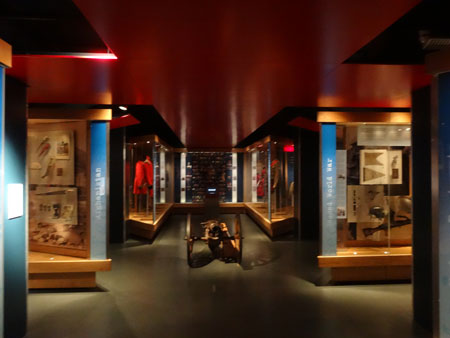
This example shows how integrating a regimental collection into a larger county museum almost inevitably results in a smaller collection being displayed more effectively.
photograph by Peter Stanley, 2015
Essentially founded in the final decades of the 17th century, the regular army increased in size as Britain became a global power. Through the 18th and 19th centuries, much of its fighting strength comprised ‘regiments of foot’ – infantry. At first the property of their colonels, they were progressively numbered and named, so Colonel Meredith’s Regiment became the 37th Foot in 1751 and in 1782 the ‘North Hampshire’ Regiment. The ‘Cardwell’ and ‘Childers’ reforms in the 1870s and 1880s created a system of ‘county regiments’, the system which remained for the two world wars and the retreat from Empire after 1945 – so the Hampshire Regiment (formed from a union of the 37th and 67th regiments in 1881) had two regular battalions which alternated between Imperial and home service, and which formed the basis of the army that expanded to fight the two world wars. As Imperial commitments declined, so the army contracted, and the Hampshire Regiment disappeared, becoming part of larger regiments representing counties across southern England.
This little history lesson explains why, around the turn of the 19th century, the 110-odd regiments of the British army established depots, mostly in their county towns, in many of which were created regimental museums as exemplars of the sense of identity and tradition that sustained the army through decades of conflict. The museum of the Hampshire Regiment, housed for the past 70 years in an early 18th-century building in Winchester, Hampshire’s county town, exemplifies the museum as the embodiment of regimental identity over more than 300 years. As long as the regiments represented the army, the War Office or the Ministry of Defence supported their museums. When the army began to contract, however, the question of their funding and even their continued existence became increasingly acute.
Virtually from the moment of the Hampshire Regiment Museum’s creation, and especially after Indian independence, the army’s infantry contracted. From 1968 it faced a succession of amalgamations and disbandments, in which regiments were combined to represent successively larger combinations of counties, and the army now comprises just 18 regiments. The Royal Hampshire Regiment (as it became in 1946) was amalgamated twice, becoming in 1992 part of the Princess of Wales’s Royal Regiment, a unit representing seven ‘Cardwell/Childers’ regiments from six counties and incorporating the history and traditions of no fewer than 12 of the old regiments of foot. Explaining this complex lineage to lay visitors in a museum is both desirable and demanding. The larger regiments’ identities are largely built upon their constituent forbears’ traditions and the collections that reflect them, but their complexity demands concentration and careful presentation difficult for museums lacking both resources and expertise.
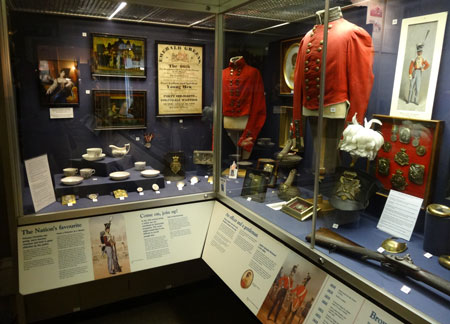
photograph by Peter Stanley, 2015
The army’s contraction confronts the army’s museums with other challenges; even of survival. When museums represented serving units they could be justified and funded as ‘training aids’. Now, however, the material heritage is little valued, or at least not as represented in so many museums. The Rifles, the army’s largest regiment, formed in 2007, is a product of the progressive amalgamation of 20 old regiments of foot. Even museum curators concede that a young veteran rifleman of Iraq or Afghanistan sees little relevance in the deeds of remote historical precursors. Nor does the Ministry of Defence, which under the ‘Army 2020’ will decline to maintain museums representing units no longer in existence from 2017.[1] Under this plan many museums are on notice that they will need to seek other sources of support: the Rifles, for instance, will support one museum, but not the four that presently exist. The trustees and managers of regimental museums have responded variously.
This is hardly a sudden crisis. The governing bodies of museums have been grappling with the consequences of their parent regiments’ amalgamation or disbandment for decades; since the first rounds of contractions in the late 1950s. Since then, some regiments (such as the Buffs (East Kent) and the Middlesex) have donated their collections to the National Army Museum when it became clear that neither local nor regimental bodies could support them. Though preserved professionally, and available to researchers, there they have effectively become lost to public attention in a large museum telling the story of the army as a whole. But the National Army Museum, located in London, is probably not a solution open to other collections (many with strong local attachments) facing uncertainty. Whether the National Army Museum, presently undergoing a major re-development using mainly Heritage Lottery funds, would welcome further donations of entire regimental collections remains an open question.
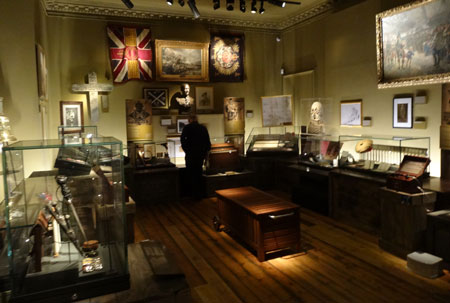
photograph by Peter Stanley, 2015
Some of the most interesting responses to the incipient crisis have been the museums that have broken out of the regimental museum’s essentially parochial mould to combine regimental collections or, more promisingly, to become part of county or other museums. Depending on the parent museum’s interest in or commitment to preserving and presenting local military history, this can be an effective option. Some traditional regimental museums survive as a ‘room’ in county museums – such as the Museum of the Queen’s Own Royal West Kent Regiment, which happily occupies a gallery in the Maidstone Museum and Bentlif Art Gallery, valued as bringing diversity to a strong local collection encompassing dinosaurs, social history, art and Egyptology. The most notable and successful reinvigoration is Somerset’s Military Museum, a gallery in the Museum of Somerset in Taunton, whose showcases use familiar ‘regimental’ collections to show how the Somerset Light Infantry fought in the wars of Empire and beyond. To do so obliges ‘regimental’ stakeholders to accept that only a portion of treasured collections will be displayed, and that the esoteric devotion of the traditional regimental museum will be supplanted by an interpretative style attuned to the needs of visitors unfamiliar with and, indeed, essentially uninterested in, the detail. (Not that combining collections common to a county is necessarily a solution. In June 2015 the Surrey Infantry Museum lost its entire museum collection when the National Trust’s 18th-century Palladian mansion, Clandon Park, burned down. Fortunately the Surreys, like many regimental museums, had transferred its archives to the county record office.)
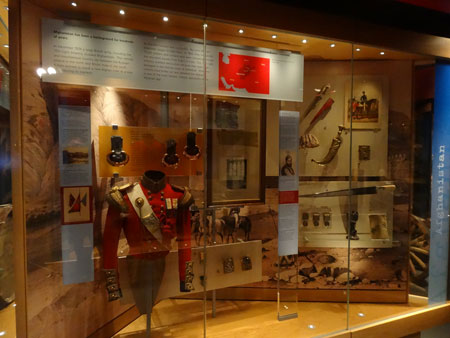
photograph by Peter Stanley, 2015
About 50 regiments, for the time being, retain their own museums, though the Army 2020 plan may make many unviable in the long term. Some thrive because of the sheer size of their collections and regimental and community support, such as the Royal Green Jackets or the Gurkhas, both in Winchester. (The ‘partnership’ between five regimental or corps museums located in Winchester, including the Royal Green Jackets, the Gurkhas and the Royal Hampshire, offers another possible solution; one unavailable to isolated museums.) Other museums survive because they are sustained by strong veteran or regional communities, such as the Black Watch, whose museum in Perth has recently been recently refurbished as a ‘Highland’ attraction. Others, such as the museum of the Royal Fusiliers, are fortuitously located in major tourist attractions (in the Tower of London), even though many visitors, especially those from overseas, may have little interest in the detail of the museum’s displays. The most astonishing survivals are those of regiments that formally went out of existence nearly 50 years ago – the museum of the Durham Light Infantry (which was disbanded in 1968) thrives because it represents a vigorous county identity.
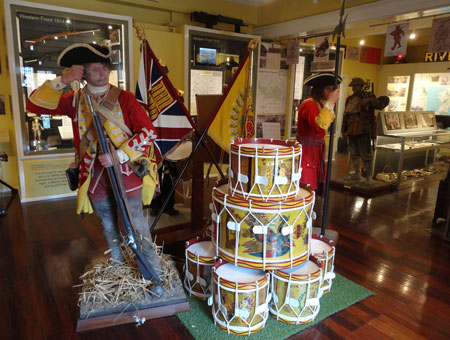
photograph by Peter Stanley, 2015
Still others receiving little or no official support, such as Cornwall’s Regimental Museum or The Rifles (Wiltshire and Berkshire) (the latter title reflecting several successive mergers), face a more uncertain future. The Rifles resorts to charging researchers steep fees (in my case of £30 per hour), and makes a steady income from hiring out its beautiful garden as a wedding reception venue. This entrepreneurial rapacity will probably not save it, despite its being located beside a major tourist attraction, Salisbury Cathedral. The museum tells a confusing story virtually incomprehensible to visitors lacking a specialist knowledge, and it cannot escape the poverty trap that precludes the refurbishment that might render it more accessible. Cornwall’s Regimental Museum, located in a former Militia ‘keep’ dating from the 1850s in Bodmin (a town off the Cornish tourist trade route) displays an astonishingly complete collection mainly detailing the history of the Duke of Cornwall’s Light Infantry, which has not existed as a separate regiment for over 50 years. Now also subsumed into the Rifles, unless its new entrepreneurial director can find new sources of funding, it will almost certainly fall victim to the cuts imposed under the Army 2020 plan.[2]
Traditional regimental museums essentially bear witness to a vanished force – the old county regiments – in the service of a lost empire. Though many tell detailed stories of the world wars that still entrance Britons, they struggle to attract popular audiences or achieve the ‘engagement’ that is the holy grail of the modern museum. They do not speak to a Britain that no longer identifies with that aspect of Britain’s story, or not enough to make 80-odd such museums sustainable. It is not even that, say, South Asian Britons do not warm to museums proudly telling of the conquest of India: seventy years after Indian independence that story is of diminishing popular interest generally. Created by devoted former members and friends of the little worlds of the county regiment, their museums seem destined to die as their former members disappear and family links erode over time. With notable exceptions, the post-Imperial contraction of the British army will surely be followed by the decline of the museums that chronicle that history.
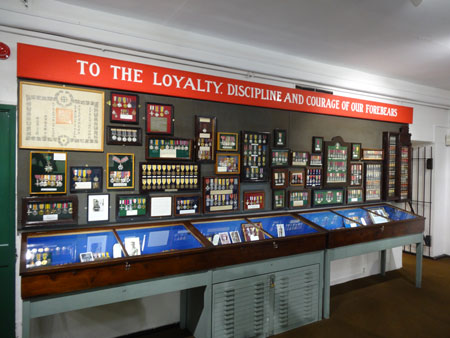
photograph by Peter Stanley, 2015
Ultimately, the discrepancy between the existing number of regimental museums and the unwillingness of the government and people of contemporary Britain to sustain them will bring about a correction; a reduction. Despite the importance of military endeavour in British history and the seemingly endless commitment of the British army to war since 2001, the more distant detail of Britain’s military history, as embodied in regimental museums, is little valued. While museums unresponsive to new realities may go under, those that attempt to tell their stories to communities broader than old comrades, especially in partnership with local or county museums, may be able to succeed. Visits to Winchester, Taunton, Salisbury, Bodmin and Maidstone in a decade’s time may reveal the results of the decisions the governing bodies of regimental museums have taken.
Peter Stanley, a member of the reCollections editorial board, formerly headed the National Museum of Australia’s Research Centre and is now Research Professor at the University of NSW Canberra. He has visited many British regimental museums as a researcher since 1987.
Endnotes
1 Army 2020 is the ‘Army’s response to the Strategic Defence and Security Review (SDSR), published by the Government in October 2010, which laid out the commitments expected of the UK Armed Forces’: http://www.army.mod.uk/structure/33449.aspx, consulted 21 September 2015.
2 Mary Godwin, project manager for the Arts Council, and with a sound background in directing small museums, has recently been appointed director of the Regimental Museum. Acknowledging the challenges of the job, she warned ‘I’m no miracle worker’: ‘County’s military museum appoints Mary as its director’, Cornish Guardian, 2 September 2015, http://www.westbriton.co.uk/Bright-future-ahead-military-museum/story-27623844-detail/story.html, consulted 21 September 2015.
